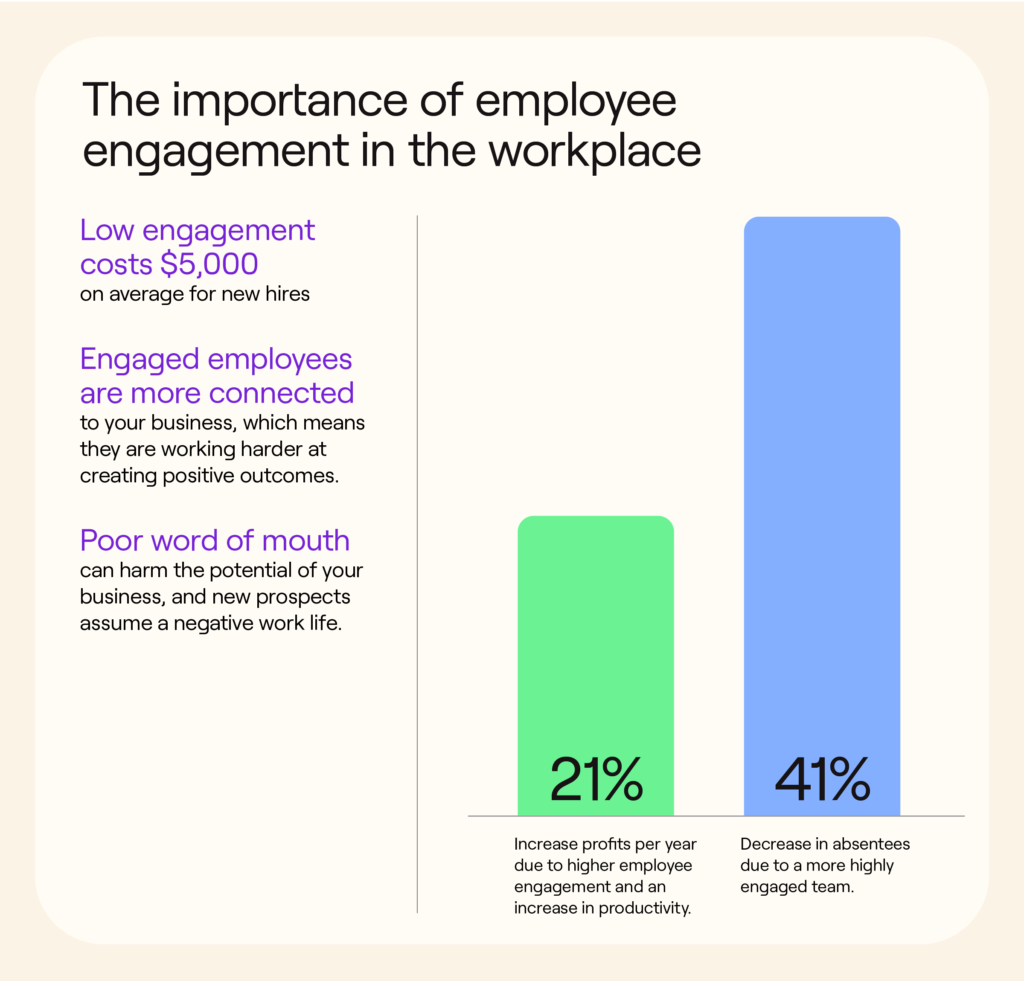
Employee engagement is vital if you want to build a successful business. Its importance in the workplace cannot be understated, and we have the statistics to prove it! Employee engagement can be the defining factor between a well-oiled, and by extension, business, or a company that is stagnant, simply treading water and achieving the bare minimum work required.
Therefore, to experience growth for your business, the following employee engagement statistics are important to understand. They can be tools to ensure that the levels of employee engagement in your workplace are considered in every process, to ensure you apply various tactics with the goal of engaged employees in mind.
Understanding the trends around employee engagement will help you to create a positive workplace.
In this article, we will dive into the statistics, along with some ways to ensure you have highly engaged employees who produce quality work. The way your employees feel and your overall employee experience have a direct correlation to the success of your business.
Disengaged employees will not provide quality work and make it much harder for your company to grow. Let’s look at how you can avoid this and keep your people engaged.
Understanding employee engagement

The modern business environment is fast-changing, and this can make it hard to retain talent. New research on more than 600 medium-sized businesses found that 63.3% of companies have a more challenging time retaining employees than hiring them. So how does your company deal with the fact that more than a third of workers are actively and continually looking for a new position?
The key is an effective employee engagement strategy. Employee engagement moves beyond ensuring you have happy employees; they also have to be engaged with the work that they do in their roles. The statistics below give us a look at the current state of engagement in the workforce, and you can consider them, along with the helpful technological tools to ensure employee engagement in your workplace.
Statistics that show the importance of employee engagement in the workplace
Engaged employees work harder to achieve your company’s goals. They go the extra mile and are directly linked to how high your chances of success will be.
This first batch of employee engagement statistics demonstrates why employee engagement should be one of the top priorities for your business:
- Employee engagement increases productivity to the tune of 21% higher profits per year
- Highly engaged teams experience 41% fewer absentees
- On the other hand, low employee engagement costs businesses $5000 on average for new hires
These statistics gives us a glimpse into why employee engagement is vital, but it’s only the tip of the iceberg. Highly engaged employees feel more connected to your business, which means they are working harder at creating positive outcomes.
The employee experience is also linked to the way peers and customers view your company. Disengaged employees cost companies far more than money, and poor word-of-mouth can spread. The rumblings of a poor company culture can harm the potential of your business, and new prospects will assume a negative work life, preventing them from considering you as an option.
The employee engagement statistics in 2020 you need to know
According to Gallup’s State of the Global Workplace, 85% of employees feel disengaged in the workplace. This shockingly small number gives you some insight into how many employees view their workplace negatively, are looking for a position elsewhere or perform the bare minimum to get through the workday.
A 2017 study sings a similar song about the importance of keeping people engaged, by stating that 81% of employees would leave their jobs for the right offer, and not even due to money! 74% of Gen Z employees say they would take a pay cut if it meant scoring their ideal position.
Employees are also more likely to actively job search if their co-workers are as well, which speaks to the importance of company culture to avoid a domino effect of staffing losses. A study on workplace engagement found that employees who are not engaged can cost around $450-550 billion each year. Low engagement means less responsibility, poor behaviour, a lack of motivation, and a drain on the overall productivity of the team and company.
The encouragement of personal agency with a range of technology and tools to monitor personal engagement is one way to prevent this situation. The goal is to connect employees to organisational missions, give them a clear career path and provide recognition. It is also important to encourage collaboration for those who need to be engaged.
1 in 3 employees are distrustful of their employers
As we’ve discussed above, employee engagement offers tangible returns, like increased profits, which go over and above employee well-being. This very real impact on your business means it is a crucial part of your strategy.
According to Gallup’s meta-analysis, companies with a highly engaged workforce score indisputably higher across the board with profitability and productivity. This includes ensuring employees have the best knowledge and tools while being aware of what is expected of them, with the full support for their professional development. A big part of ensuring this is effective communication. 91% of employees say that their management teams lack communication skills with 1 in 3 employees claiming that they do not actually trust their employers.
Around 1 in 3 workers claim boredom is their reason to leave

In this 2018 Korn Ferry Survey, a lack of job satisfaction is noted as the result of boredom. A huge 33% of those surveyed said they were seeking new challenges or the work culture didn’t align with their values. Interestingly, the search for a larger salary was the fourth biggest reason for dissatisfaction, with only 19% choosing it as a reason to leave.
This shows that challenging your staff and giving them a chance to develop and learn is critical. Companies will benefit from this as well as a workforce with higher skills and competencies leads to a more profitable company.
29% of employees say they are satisfied with their career advancement
Around 37% of the workforce cite recognition as the most prominent method of support, be it privately or publicly in front of their peers. Employees who feel like they have been taken for granted will drop levels of employee engagement significantly.
Recognition leads to heightened motivation, and 84% of employees who were recognised for going above and beyond showed signs of much higher engagement. Recognising and rewarding is easier than you may think, and there are many ways to do this. Even with newer ways of working, like work-from-home situations, there are plenty of ways to recognise and reward your team.
Career advancement opportunities, for example, are a double-edged sword in terms of showing your staff that you see the good work they are doing while also ticking the second box in the employee engagement checklist; development to keep them engaged.
According to a 2017 engagement report, only 29% of employees say they are satisfied with their career advancement with 41% stating that it is vital to job satisfaction. This shows that career development opportunities, learning and personal growth are critical. Professional development seems to be of particular importance to the younger generations of which a huge 87% claim it is a necessity.
The 11 main types of employee engagement
There are a lot of strategies that will help you ensure that your employees are engaged at work. You can choose one, or a few of the following to focus on:
- Make your organisation’s values clear and defined
- Create a shared purpose
- Ensuring a safe work environment
- Recognise performing employees with rewards
- Ensure both physical and mental health and wellbeing
- Defining individual roles
- Nurturing relationships
- Provide clear communication channels
- Foster leadership skills in every team member
- Work on personal development
- Create Psychological Safety
Understanding the level of enthusiasm, passion and connection in your business can be made much easier with an employee survey.
This is a great way for management and HR leaders to measure how motivated and committed your team is to the company. You’ll gain a better understanding of happiness levels and how best to influence your employees to work hard and stay in their roles by gathering your own employee engagement statistics.
Read more: What benefits do employees want at work?
Tools to help
There is various technology available to help you action everything you need to increase employee engagement.
Establishing OKRs (Objectives and Key Results) is a proven way to manage your team’s goals. This will ensure transparency across the entire business, along with how an individual staff member can contribute to the broader goals.
Employment Hero people management software provides a way to keep your engagement levels high by giving employees visibility over their own details. It can help to reduce employee procedures via a self-service portal that allows employees to access their own employee file, request leave for approval, update their own superannuation, view payslips and more. This helps to build trust while also increasing efficiency and reducing admin tasks.
Additionally, the Employment Hero mobile app allows all of these key functions to be performed on the go, making employee engagement much simpler for staff and HR leaders. Through the app, leave, and timesheets can be managed, policies and contracts reviewed, and much more. There is also a staff directory for all contact details and access to InstaPay, which offers earned wages before payday.
Ensuring quality employee engagement in the workplace
Effective internal communications are a fundamental way to increase employee engagement and lower frustration in the workplace. The typical worker spends 2.5 hours a day, searching for information. This is not only a waste of time, but it shows when key information is missing, you are forcing your employees to look for it themselves. This causes frustration, wastes time and lowers productivity in the workplace.
Your employee engagement strategy and internal communication are intrinsically linked. Hopefully, these employee engagement statistics have shown you just how vital it is to ensure engaged employees in the workplace.
The bottom line is that engaged employees are more likely to stay with your company, and monitoring your engagement stats is the best way to keep things on track. You want to get the best work possible from engaged employees, and they want to give you that work!
Ensuring high engagement levels means it is less likely that your company will lose quality staff, and everyone will feel happier and more satisfied at work, and who doesn’t want that! Employment Hero are the leading HR Software, Payroll and Benefits cloud platform. With remote working being the future of work, learning how to keep employees engaged is more important in 2021 than ever. Click here to book a demo today!
The Ultimate Employee Engagement Guide
